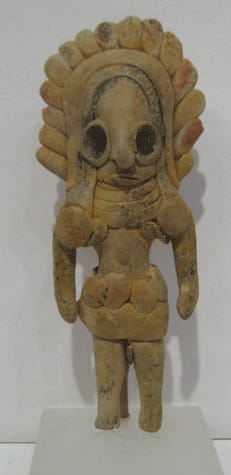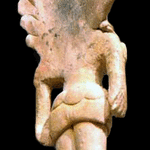Indus Valley Terracotta Figurine of a Fertility Goddess, 2600 BCE - 1900 BCE
Terracotta
2.75
LO.567
The Indus Civilization still represents very much an archaeological conundrum: an ancient civilization with a yet-to be deciphered writing system, a mysterious monumental architecture, no so-called 'monumental' art, a puzzling...
The Indus Civilization still represents very much an archaeological conundrum: an ancient civilization with a yet-to be deciphered writing system, a mysterious monumental architecture, no so-called 'monumental' art, a puzzling decline, and little evidence of the identity of its direct descendants. In a civilization extending over an area so vast, one would expect to find monumental art and/or architectural symbols of power displaying the names of the powerful. Instead, the emphasis is placed on small, elegant art and sophisticated craft technology.
Three-dimensional representations of living beings in the Harappan world are confined to a few stone and bronze statues and some small objects crafted in faience, stone, and other materials - with one important exception. Ranging variously in size, the anthropomorphic and animal terracotta figurines the Indus Civilization sites depict life as seen by the Harappan people in the Bronze Age.
At the peak of the Indus Civilization or the Harappan Period (2600-1900 BCE) -to when this beautiful figurine dates back-, the most common dress for female figurines was the belt and/or short skirt usually situated at the same point on the hips as the figurine’s hands. The fan-shaped headdress was one of the most commonly depicted Indus headdresses. Figurine headdresses were typically decorated in a variety of ways through the addition of terracotta cones, twisted ropes (possibly representing hair), flowers and other applied ornaments.
This beautiful figurine with her rich applique' ornamentation would have probably been used as a ludic entertainment, although the high number of excavated exampls would also seem to point out to a permeating belief in the magic aura of the feminine spirit, so beautifully portrayed in such a simple, yet refined way.
For comparable examples see: Jarrige, C. Les Figurine Humaines au Baluchistan, in Les Cites Oubliees de l'Indus, edited by J-F. Jarrige, 1988: pp.65-70.
Three-dimensional representations of living beings in the Harappan world are confined to a few stone and bronze statues and some small objects crafted in faience, stone, and other materials - with one important exception. Ranging variously in size, the anthropomorphic and animal terracotta figurines the Indus Civilization sites depict life as seen by the Harappan people in the Bronze Age.
At the peak of the Indus Civilization or the Harappan Period (2600-1900 BCE) -to when this beautiful figurine dates back-, the most common dress for female figurines was the belt and/or short skirt usually situated at the same point on the hips as the figurine’s hands. The fan-shaped headdress was one of the most commonly depicted Indus headdresses. Figurine headdresses were typically decorated in a variety of ways through the addition of terracotta cones, twisted ropes (possibly representing hair), flowers and other applied ornaments.
This beautiful figurine with her rich applique' ornamentation would have probably been used as a ludic entertainment, although the high number of excavated exampls would also seem to point out to a permeating belief in the magic aura of the feminine spirit, so beautifully portrayed in such a simple, yet refined way.
For comparable examples see: Jarrige, C. Les Figurine Humaines au Baluchistan, in Les Cites Oubliees de l'Indus, edited by J-F. Jarrige, 1988: pp.65-70.



